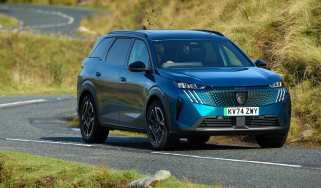London Congestion Charge exempt cars: do electric cars pay to enter the CCZ?
Do electric cars have to pay the London Congestion Charge? We explain the ins and outs of this daily levy for entering London's Congestion Charge Zone (CCZ)

In February 2003, the London Congestion Charging Scheme was introduced in order to address traffic and local air pollution in the Capital. Initially the Congestion Charge area only covered 22 square kilometres but in February 2007 the area doubled in size to the current 'Congestion Charge Zone', or CCZ for short.
This is not to be confused with the ULEZ (Ultra Low Emission Zone) introduced in 2019, which has since expanded and is set to expand again in 2023.
When you come to London it will be clear when you are entering the CCZ, you will spot a sign showing a white 'C' on a red circle and the words 'Congestion Charge'. The zone currently covers an area bordered roughly by the A501 inner ring road to the north, Hyde Park and Victoria to the west, Vauxhall Bridge at its southern tip, and Tower Bridge to the east. While the ULEZ is set to grow, there are currently no public plans to expand the Congestion Charge zone.
2020’s Covid pandemic lockdown saw the zone temporarily suspended, but the charge was brought back at a higher rate of £15 a day and with expanded operating hours from June 2020. Since February 2022, the Congestion Charge has applied from 7am to 6pm on weekdays and from midday to 6pm on Saturdays, Sundays and Bank Holidays but there is no charge between Christmas Day and New Year's Day bank holiday.
While low-emission vehicles previously escaped the Congestion Charge, these days only fully zero-emissions cars are exempt. But that won't be the case forever, as current plans see that exemption expire in December 2025. Note that exempt cars do not automatically escape the charge – they have to be registered as such beforehand with Transport for London (TfL).
What cars are exempt from the London Congestion Charge?
Until the 25th of December 2025, all purely electric cars, vans and other vehicles are Congestion Charge-exempt, because they have zero tailpipe emissions. This means if you drive a fully electric vehicle and register it with Transport for London (TfL) you won’t have to pay the Congestion Charge. Hybrid vehicles – even plug-in hybrids capable of running on pure-electric power for some distance – are not exempt. After December 2025, these drivers will incur the same £15 daily charge as all other drivers.
There are discounts available to residents living within the Congestion Charge Zone who can apply for up to a 90% Residents’ Discount from Transport for London, meaning they'll pay £1.50 every day they drive in the zone. You need to supply documents to prove your residency as well as the fact that you're the owner, registered keeper or authorised user of the vehicle in question. The discount costs residents £10 a year.
Blue Badge holders don't have to pay the Congestion Charge at all. However, as with all the other exemptions, it’s vital that the vehicles used by a Blue Badge holder – a maximum of two per badge – are first registered with TfL in order to qualify for exemption. The Blue Badge discount too still costs £10 and must be renewed in line with the Blue Badge expiry date, though if you renew within 90 days of the expiry date, no further charge is due.
Other vehicles facing no charge are those with nine or more seats, breakdown and recovery vehicles, and two-wheeled motorcycles or mopeds.
How does the London Congestion Charge work?
You only have to pay the charge once a day. That means you can drive in and out of the Congestion Charge Zone (CCZ) many times on the same day without facing further penalties. You pay the charge online, on Transport for London's website.
You can also pay the charge in advance, or wait until the next day to pay. However, doing the latter adds £3.50 to the total, bringing it to £18.50. Fail to pay by midnight the following day, and you’ll be served with a Penalty Charge Notice (PCN).
This fee has gone up recently to £180, though if you pay within 14 days, this is discounted to £90 – still a hefty sum, so if you think you’ll be entering the CCZ, it’s wise to pay as soon as possible. It is possible to appeal a PCN under certain conditions; for example, if you’ve already paid the charge, or your car is exempt and the PCN was served in error. A full list of conditions can be found on the TfL website.
How do you pay for the London Congestion Charge?
Paying to enter the Congestion Charge Zone (CCZ) is simple and can be done in advance of your travel date. Just visit the Transport for London (TFL) website, head to the ‘Pay to drive in London’ section, click 'Pay', and follow the prompts to input your vehicle details and desired travel date. It's a simple process. Plus, you can conveniently settle the fee for the Ultra Low Emission Zone simultaneously.
What about the Ultra Low Emission Zones?
The London Ultra Low Emission Zone (ULEZ) was introduced in April 2019, operating 24 hours a day, seven days a week (except no charge between Christmas Day and New Year's Day bank holiday) in the same boundaries as the Congestion Charge Zone at the time. It’s completely separate to the Congestion Charge and drivers who enter the ULEZ zone and the Congestion Charge in a non-compliant vehicle have to pay both charges.
Petrol cars and vans that don't meet at least the Euro 4 emissions standard (and motorcycles that don’t meet Euro 3) have to pay £12.50 to enter the ULEZ area, while diesel cars and vans that don't meet at least the Euro 6 standard are liable for the charge.
This means that while Euro 4 and 5 petrol cars get away with not paying the ULEZ charge, Euro 5 diesels and earlier have to pay it. As a rough guide, diesel cars and vans registered before September 2016 aren't Euro 6 compliant. If in doubt, use TfL's online vehicle checker to see if you need to pay.
The ULEZ expanded on 25 October 2021 to encompass the entire 'inner London area' (i.e. the zone bounded by the North and South Circular Roads), and was expanded again on 29 August 2023. The new zone is considerably larger than before, covering all London Boroughs, extending out as far as the M25 in some places.
Given the number of London residents this will affect, the Mayor of London, Sadiq Khan, has set aside £110 million towards a scrappage scheme, in an effort to either get people into a cleaner vehicle, or help them retrofit an older one. Sadiq Khan has also stated that all Londoners who own non-compliant cars will be eligible for up to £2,000 to replace them on this scheme.
As with the CCZ, there is a £180 penalty charge if you haven’t paid the ULEZ fee by midnight of the day after your visit, with the same early payment discount of £90. There is a grace period until 24 October 2027 for vehicles registered to disabled and wheelchair access owners, as well as a handful of other concessions for certain vehicles; it’s worth checking the TfL website if you think your vehicle might be eligible.
It’s worth noting too that historic vehicles of more than 40 years old are also eligible for exemption, alongside their exemption from MOT testing and zero-rate VED.
What are other UK cities doing?
Birmingham, Bath, Bristol, Glasgow and Bradford are just five examples of UK cities that have successfully introduced clean-air zones, while Oxford has implemented a zero-emission zone (ZEZ) for its city centre. It’s free to enter Oxford’s ZEZ in an electric car, but hybrids that emit less than 75 g/km CO2 are charged £2 a day, vehicles that meet Euro 4 petrol and Euro 6 diesel standards are charged £6, while those that don’t meet any of those standards incur a £10 charge every time they enter. Charges for each clean-air or zero-emission zone are likely to be different, so best to check before you set off.
Several other cities have considered clean air zones but as of yet, the cities above are the only ones to implement these schemes.
Most Popular

EV Deal of the Day: family-friendly Peugeot E-5008 for £261 per month

